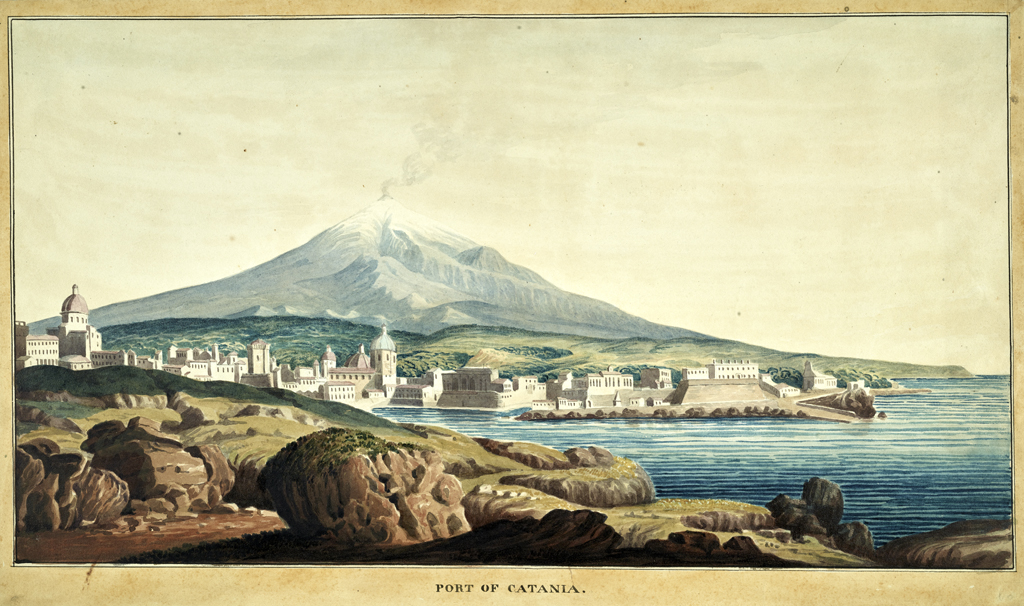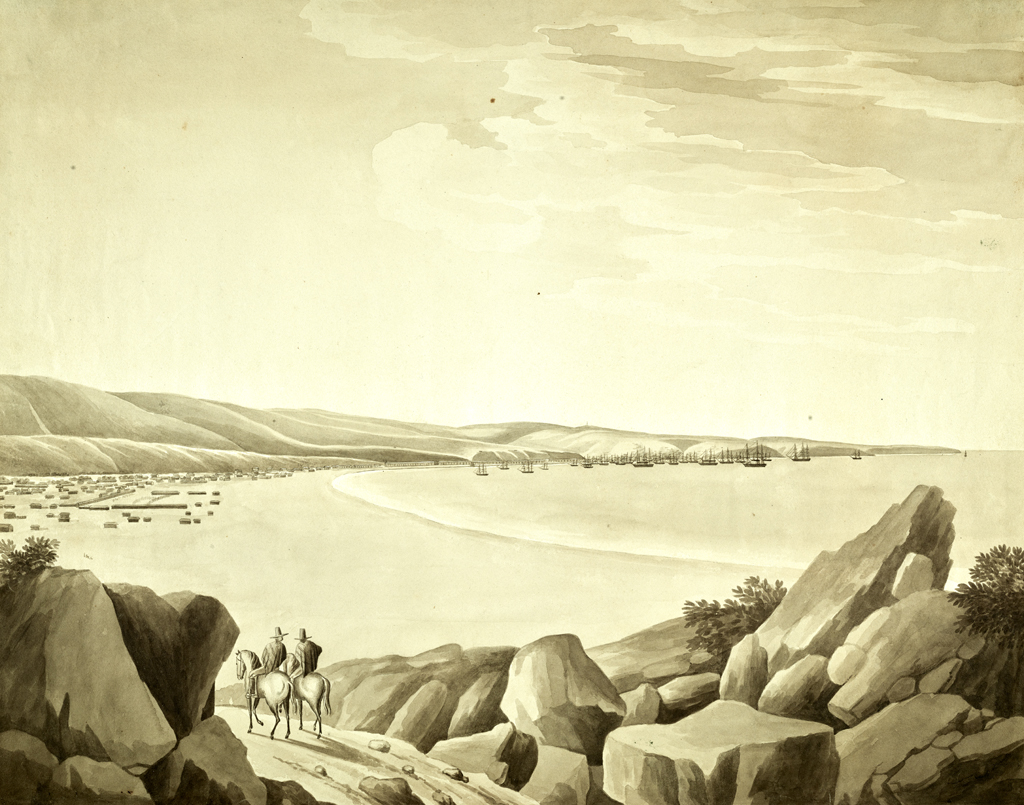A recent inquiry from the Assistant Professor of Mediterranean History and Archaeology at New York University’s Institute for the Study of the Ancient World brought a really cool assemblage of watercolors in our collection to my attention. The images were painted by Joseph Partridge, an artist turned Marine stationed aboard USS Warren between 1827 and 1830.
Partridge was born in England in 1792 and moved to Halifax, Nova Scotia in 1817 where he opened a school to teach watercolor drawing. A few years later he moved to Boston and then Providence, Rhode Island where he again advertised for art students. By 1824 Partridge was living in abject poverty in Taunton, Massachusetts. Still an unsuccessful artist and teacher, Partridge enlisted as a Private in the US Marine Corps on August 26, 1825. Interestingly, his enlistment papers show his occupation as an “anatomical painter” but the majority of the images in our collection are landscapes. [Looking at his rather amateurish portraits it’s no wonder why he wasn’t wholly successful! I’ve included one at the bottom of this post so you can form your own opinion.]
Following his enlistment, Partridge reported to the Charlestown Navy Yard and remained there until January 1, 1827 when he was assigned to Warren. Partridge spent the next three years aboard the ship and it was during this time that he produced his greatest body of work: watercolors depicting the ship and places it visited and two portraits of interesting people he encountered (which will be the subject of my next blog post!).

USS Warren was a second-class 697-ton sloop-of-war built at the Boston Navy Yard. It was commissioned on January 14, 1827 with Master Commandant Lawrence Kearny in command. On February 22nd Warren sailed for the Mediterranean to become part of the naval squadron tasked with protecting American merchant ships from Greek-flagged pirates. The Greek War of independence had erupted in 1821 and by 1827 the Greek Navy and many private citizens had turned to piracy as a way of acquiring supplies and supporting the rebellion.
To protect American trade, the squadron established a regular convoy system between Malta and Smyrna (Izmir, Turkey). Besides escorting convoys and protecting merchantmen, Warren played a pivotal role in reducing Greek depredations by actively patrolling the Greek archipelago and seizing or destroying Greek-flagged vessels suspected of engaging in piratical activities. As the ship moved through the Aegean and Mediterranean seas Partridge painted views of the islands and ports the ship passed by or visited.


The ship arrived at Gibraltar on March 26 and after a short stay headed for Port Mahon (Minorca) in order to check in with the commodore of the squadron, John Rodgers. Warren then headed to Malta to assemble a convoy but diverted to Syracuse to avoid being detained by Malta’s quarantine practices. While in Syracuse Partridge painted an image of the landmark known as the “Ear of Dionysius.” Unfortunately the image is lost. This image of the town of Catania and a looming, snow-capped but smoking Mount Etna, which is close to Syracuse, may have been created around the same time. The ship left Syracuse on May 15th and after a quick call for a pilot at Milos arrived in Smyrna on June 14th.


Leaving Smyrna on June 16th the ship made a quick stop and Vourla (Urla, Turkey) to take on water. After leaving Urla the ship passed Ipsara (Psara, Greece), sailed through Doro Passage and anchored at Poros. It is with Partridge’s image of Poros that we learn that Commandant Kearny was apparently engaging in a little side business with his brother Francis, a noted engraver and publisher in the United States. Kearny apparently “directed” Partridge to create landscape images which he then sent to Francis for engraving and printing. Francis published four of Partridge’s images although only one identifies the artist, the rest are simply marked “original drawing done under the direction of an officer in the U.S. Navy”–one wonders how much poor Mr. Partridge benefited from this arrangement!


After leaving Poros the ship sailed through the straits around Hydra, Greece and headed up the Argolic Gulf to Napoli di Romania (Nafplio, Greece) where they anchored on June 23rd. The following day clerk James Parker and four or five officers climbed about a million stairs to reach the Palamidi Castle–the large fortress that guards the town. Parker called the fortress “the strongest fortress on the seaboard, and one of the strongest in all Greece.” At the time of Warren’s visit the Castle was under the control of General George Grevis, a tough man who wasn’t above opening his batteries on the town if he wasn’t happy with the quality of the supplies they provided!

Warren’s pirate hunting activities started in earnest after escorting a convoy from Smyrna on September 25, 1827. The ship separated from the convoy about 180 miles west of Cerigo (Kythera, Greece) to cruise between Cape Matapan and Carabusa (Gramvousa, Crete). Her first captures occurred on October 4th with a small “piratical boat” crewed by “fourteen well-armed men and one boy.” Just a few hours later they caught a newly-built 180-ton brig.

Over the next few weeks the ship continued cruising and occasionally ducked into ports to check for ships that needed convoying. Warren frequently chased suspicious vessels including one particularly long chase of a suspicious looking brig from Cape Spada in Crete all the way up the Argolic Gulf. This event gave Partridge another chance to paint Napoli di Romania and he may have painted the island of Spezzia (Spetses, Greece) around the same time.


While at Milos on October 26th Kearny learned from a French store ship of pirate attacks on the brigs Cherub, Rob Roy and Susana. The ships had been part of a convoy escorted by USS Porpoise but had separated from it on October 15th only to find themselves surrounded by pirates the following day while sailing between Tinos and the pirate stronghold of Mykonos.

While sailing towards the site of the attacks Warren spotted a hermaphrodite brig trying to hide behind the island of Argentira (Kimolos). The brig was pursued and grounded on the south side of the island. Warren fired 40 cannon shots into the vessel and rocks along the shoreline in an effort to capture some of the crew but the pirates successfully escaped into the mountains. Since the vessel was believed to have robbed Cherub, shore parties stripped off its sails and rigging, cut away its masts and sent it to the bottom of the harbor.

A few days later Warren located Cherub and towed her to Syra (Syros, Greece) where she was left under the protection of USS Lexington. Warren resumed the hunt and the next day while sailing between Tinos and Mykonos found the Austrian brig Silence robbed of everything on board–including her sails, rigging and even the men’s clothes! At that point it became clear to Kearny that Mykonos was the source of many of the depredations and he resolved to combat the problem at its source.
After towing Silence to Syros, Warren cruised around Mykonos and captured every vessel it could find including a large tratta “capable of rowing 40 oars.” On October 31st Kearny sent a strongly worded message to the island’s governor in which he demanded explanations and “atonement” for the crimes and the restoration of the stolen materials or he would use the “force which is at my disposal.”

The ship entered Mykonos harbor on November 1st with permission to send search parties ashore to hunt for pirates and piratically plundered property, but cooperation from the island’s inhabitants was not forthcoming so Kearny launched a small bombardment of the town and temporarily took a few local authorities captive. Two or three houses were struck and there were no casualties but the townspeople quickly changed their minds about cooperating with the Americans.
Within a few minutes several vessels came alongside Warren loaded with parts of Cherub’s cargo so Kearny sent a detachment of men ashore to recover everything they could. According to clerk James Parker all the houses of the town were literally stuffed to the gills with stolen cargo including sails, rigging, figs, raisins and many other items. They also recovered two cases of opium taken from Rob Roy, and the sails and rigging taken from Silence. The townspeople also turned over four men accused of being pirates and the landing party picked up a fifth in the mountains.

The ship returned to Syros on November 7th and Kearny returned the recovered cargo and gear to the plundered vessels. Not wasting any time, Warren put to sea that evening and headed for the island of Andros where Lieutenant William Hudson led a boat expedition around the island. Near the south end of the town they captured one small “piratical craft” and burned another. The American sailors also blew up a house owned by a reputed pirate and raised and took possession of a boat that had been sunk in the harbor to avoid detection. Rob Roy’s master later identified the boat as the craft that attacked his vessel. Possibly hearing of Warren’s attack on Mykonos the people of Andros turned over a pirate boat containing a 12-pound carronade and tools from Cherub.

On November 18th, Warren entered the port at Milos and stayed there until late November. On the 27th of that month, the American brig Sarah and Esther and six other vessels arrived and three days later sailed for Smyrna under Warren’s protection. They arrived at their destination, without incident, on December 6th.

Warren remained in the western Mediterranean guarding American commerce for the next two years. Captain Kearny left the vessel in late June 1829 while the ship was at Port Mahon. USS Warren and Partridge returned to Norfolk on August 31, 1830 and Sergeant Partridge was honorably discharged from the US Marine Corps at Gosport, Virginia on October 18, 1830 and died at some time before 1834.


